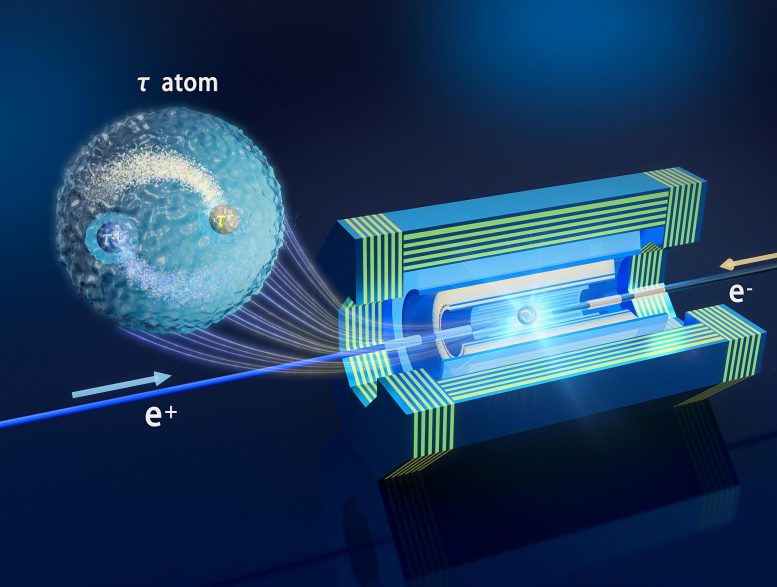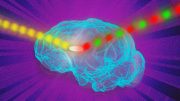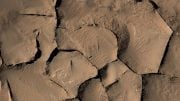
Tauonium: The Smallest and Heaviest Atom with Pure Electromagnetic Interaction. Credit: ©Science China Press
Recent discoveries in quantum physics have revealed simpler atomic structures than hydrogen, involving pure electromagnetic interactions between particles like electrons and their antiparticles. This advancement has significant implications for our understanding of quantum mechanics and fundamental physics, highlighted by new methods for detecting tauonium, which could revolutionize measurements of particle physics.
The hydrogen atom was once considered the simplest atom in nature, composed of a structureless electron and a structured proton. However, as research progressed, scientists discovered a simpler type of atom, consisting of structureless electrons (e-), muons (μ-), or tauons (τ-) and their equally structureless antiparticles. These atoms are bound together solely by electromagnetic interactions, with simpler structures than hydrogen atoms, providing a new perspective on scientific problems such as quantum mechanics, fundamental symmetry, and gravity.
Discovery of Electromagnetic Interaction Atoms
To date, only two types of atoms with pure electromagnetic interactions have been discovered: the electron-positron bound state discovered in 1951 (Phys Rev 1951;82:455) and the electron-antimuon bound state discovered in 1960 (Phys Rev Lett 1960;5:63). Over the past 64 years, there have been no other signs of such atoms with pure electromagnetic interactions, although there are some proposals to search for them in cosmic rays or high-energy colliders.
Tauonium, composed of a tauon and its antiparticle, has a Bohr radius of only 30.4 femtometers (1 femtometer = 10-15 meters), approximately 1/1741 (0.057%) of the Bohr radius of a hydrogen atom. This implies that tauonium can test the fundamental principles of quantum mechanics and quantum electrodynamics at smaller scales, providing a powerful tool for exploring the mysteries of the micro material world.
Recently, a study titled “Novel method for identifying the heaviest QED atom” was recently published in the comprehensive journal Science Bulletin, proposing a new approach used to discover tauonium. The study demonstrates that by collecting data of 1.5 ab-1 near the threshold of tauon pair production at an electron and positron collider, and selecting signal events containing charged particles accompanied by the undetected neutrinos carrying away energy, the significance of observing tauonium will exceed 5σ. This indicates a strong experimental evidence for the existence of tauonium.
Implications for Fundamental Physics
The study also found that using the same data, the precision of measuring the tau lepton mass can be improved to an unprecedented level of 1 keV, two orders of magnitude higher than the highest precision achieved by current experiments. This achievement will not only contribute to the precise testing of the electroweak theory in the Standard Model but also have profound implications for fundamental physics questions such as lepton flavor universality.
Future Research Directions
This achievement serves as one of the most important physical objectives of the proposed Super Tau-Charm Facility (STCF) in China or the Super Charm-Tau Factory (SCTF) in Russia: to discover the smallest and heaviest atom with pure electromagnetic interactions by running the machine near the tauon pair threshold for one year and to measure the tau lepton mass with a high precision. These discoveries will provide deeper insights and understanding into humanity’s exploration of the microscopic world.
Reference: “Novel method for identifying the heaviest QED atom” by Jing-Hang Fu, Sen Jia, Xing-Yu Zhou, Yu-Jie Zhang, Cheng-Ping Shen and Chang-Zheng Yuan, 4 April 2024, Science Bulletin.
DOI: 10.1016/j.scib.2024.04.003









Patent thomas institute for technology research
I am number dyslexic, so no science for me.
Your articles are brilliant in their ability to help me visualize what I cannot fathom
mathematically. Thank you
Just don’t make a bomb out of it.
Its very good information fo BSC students